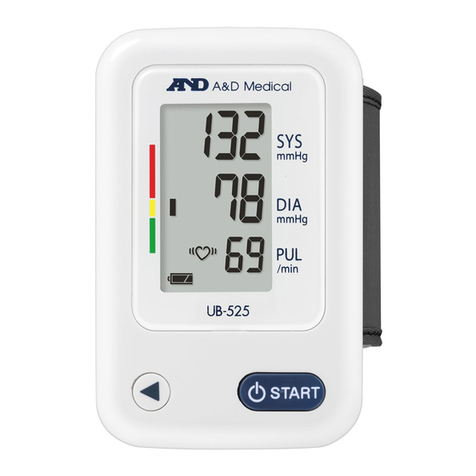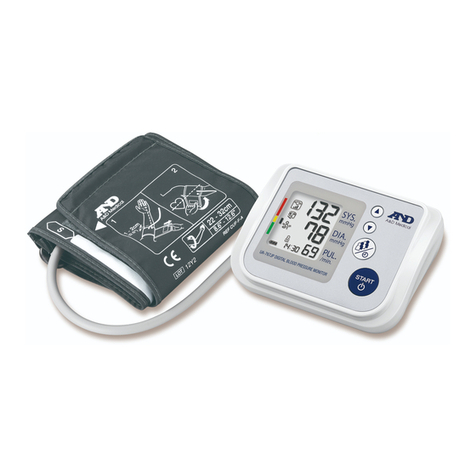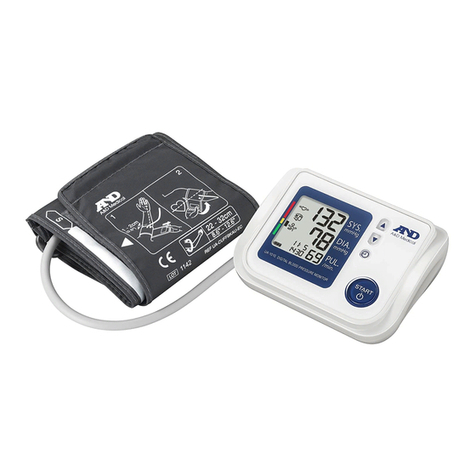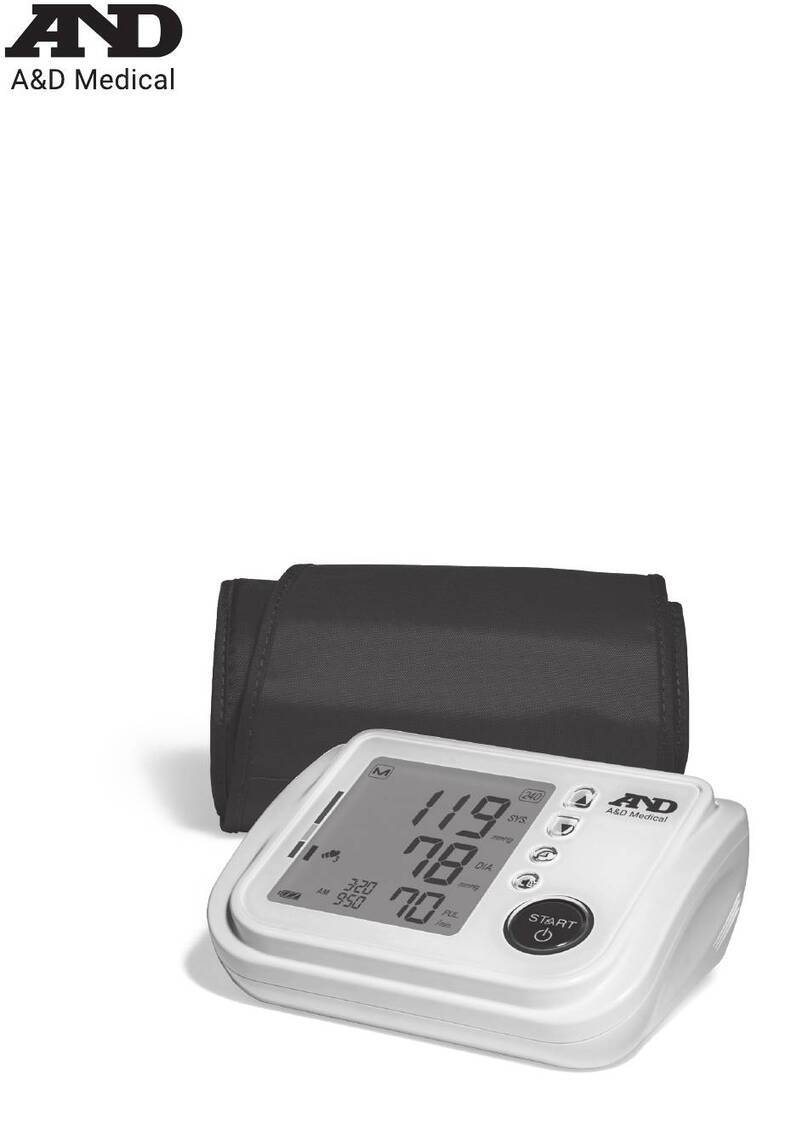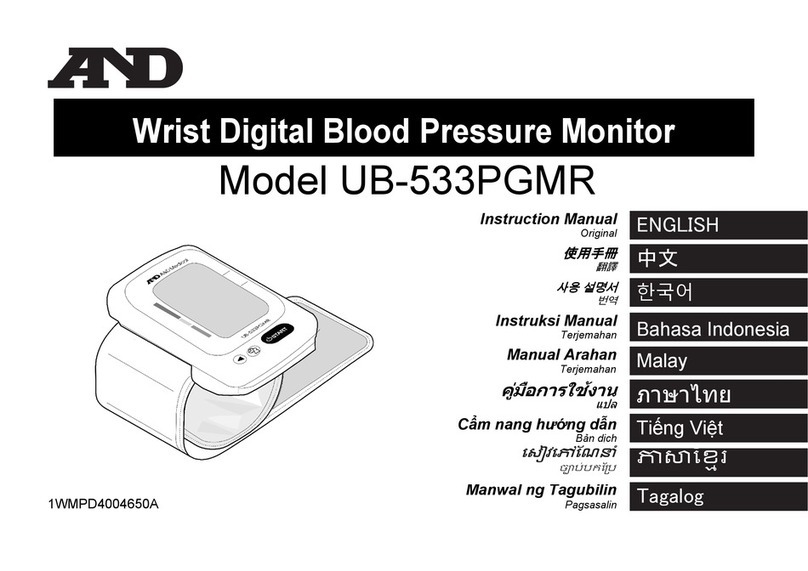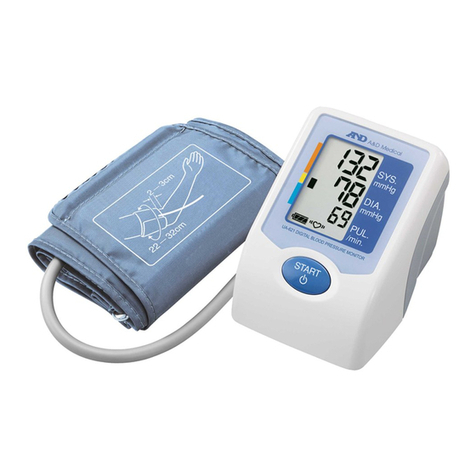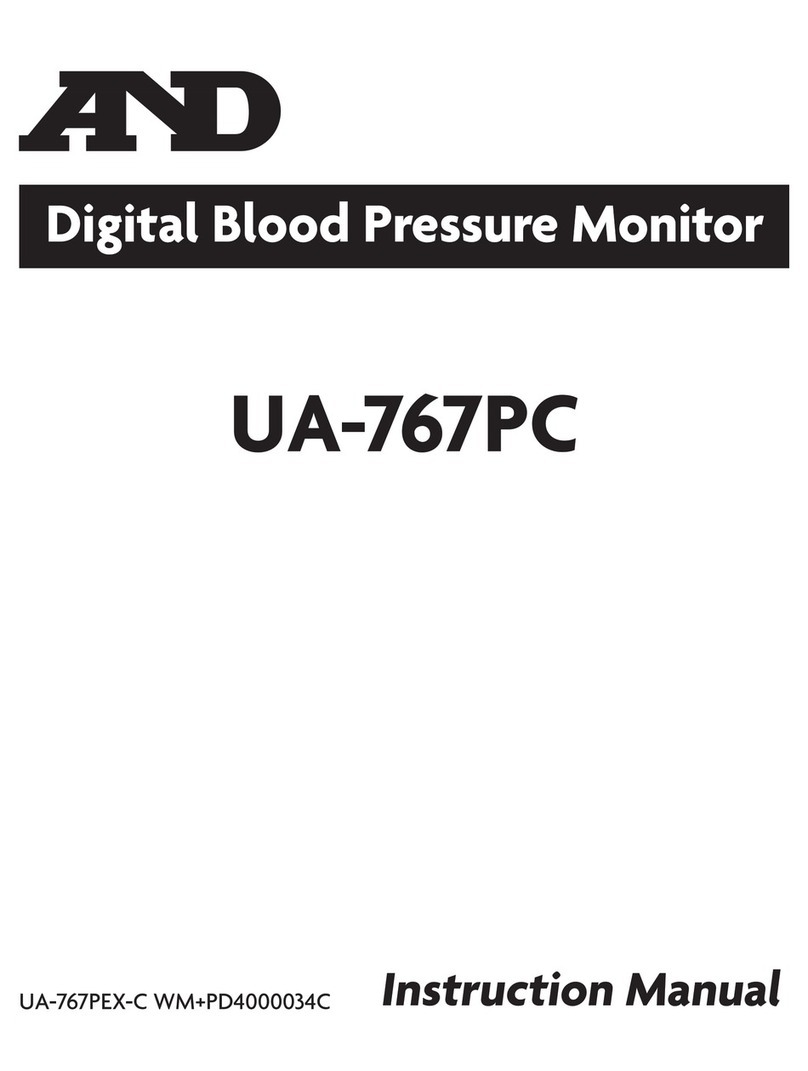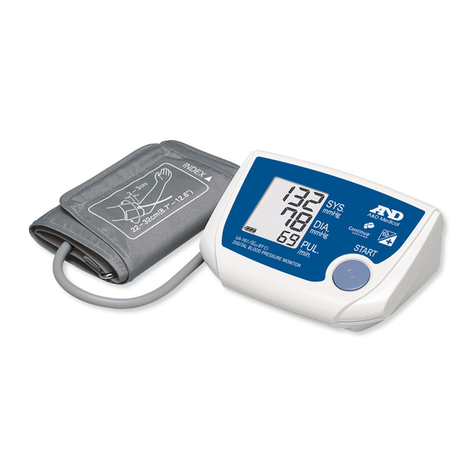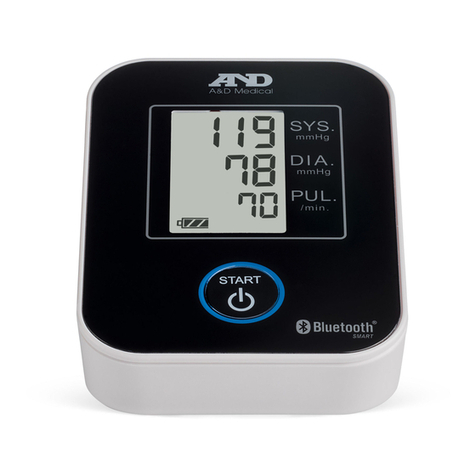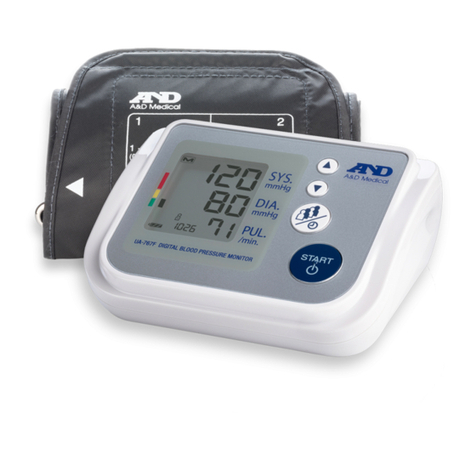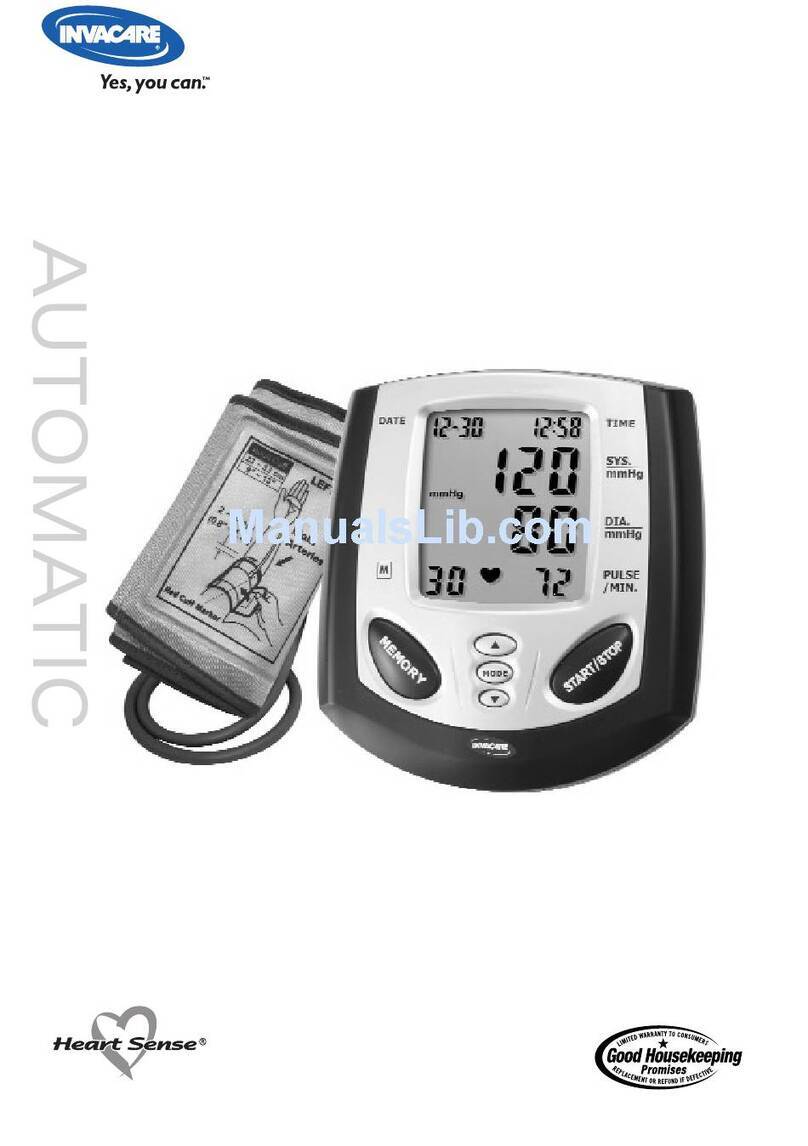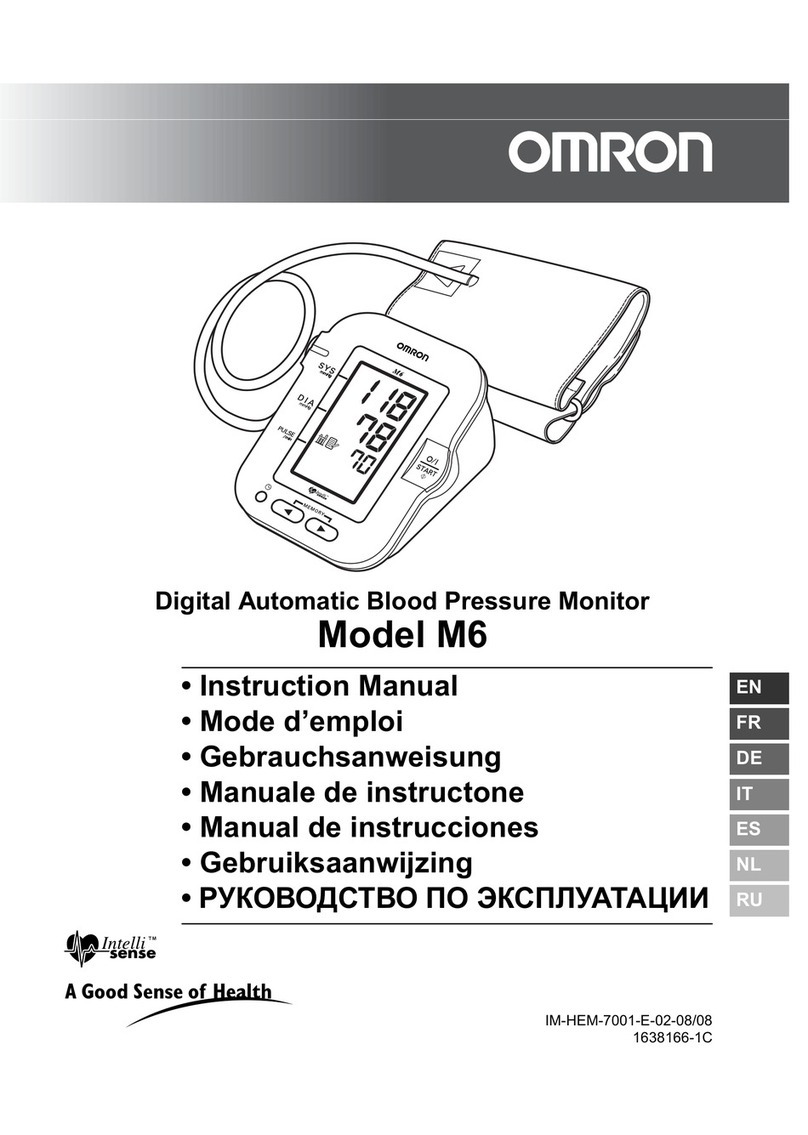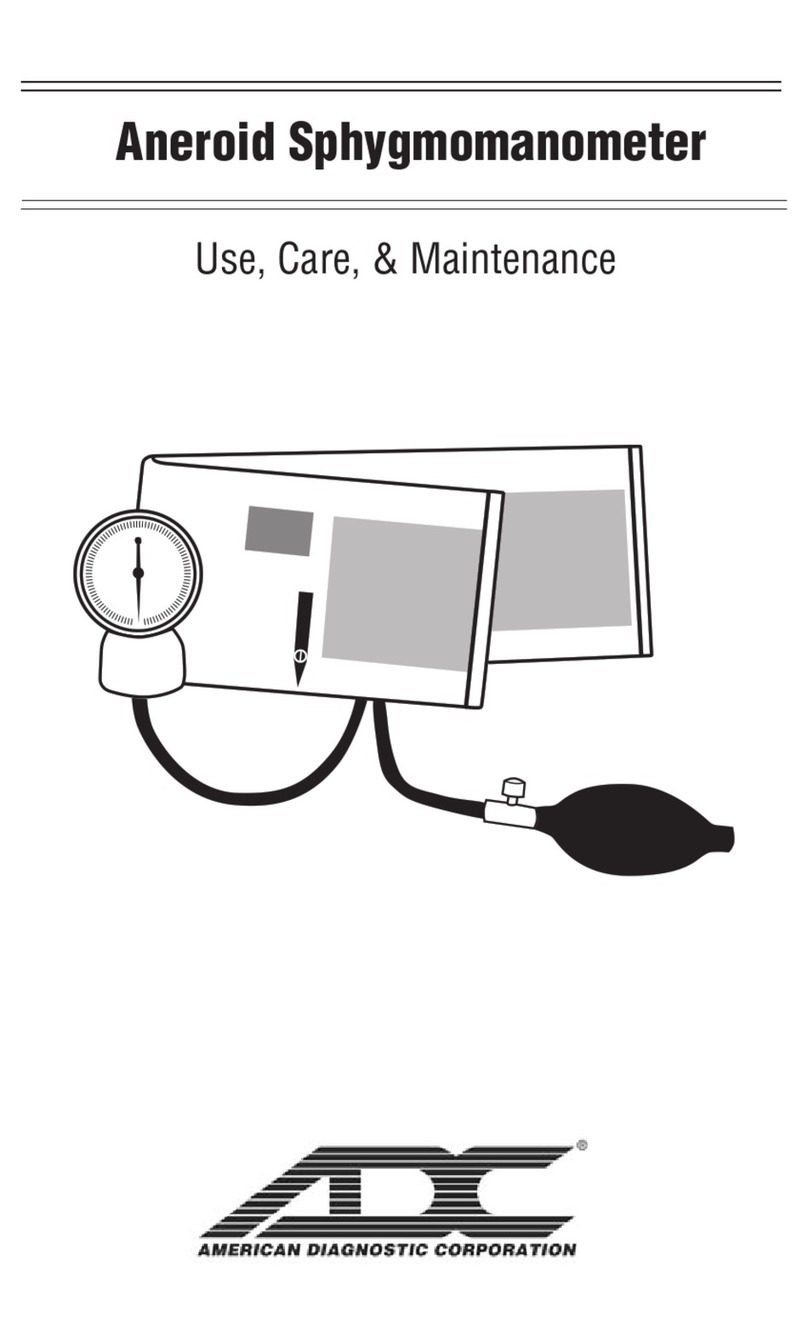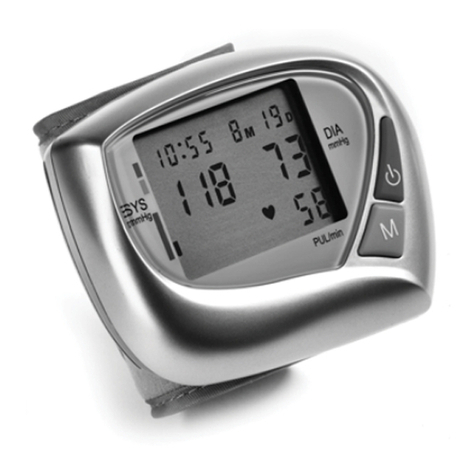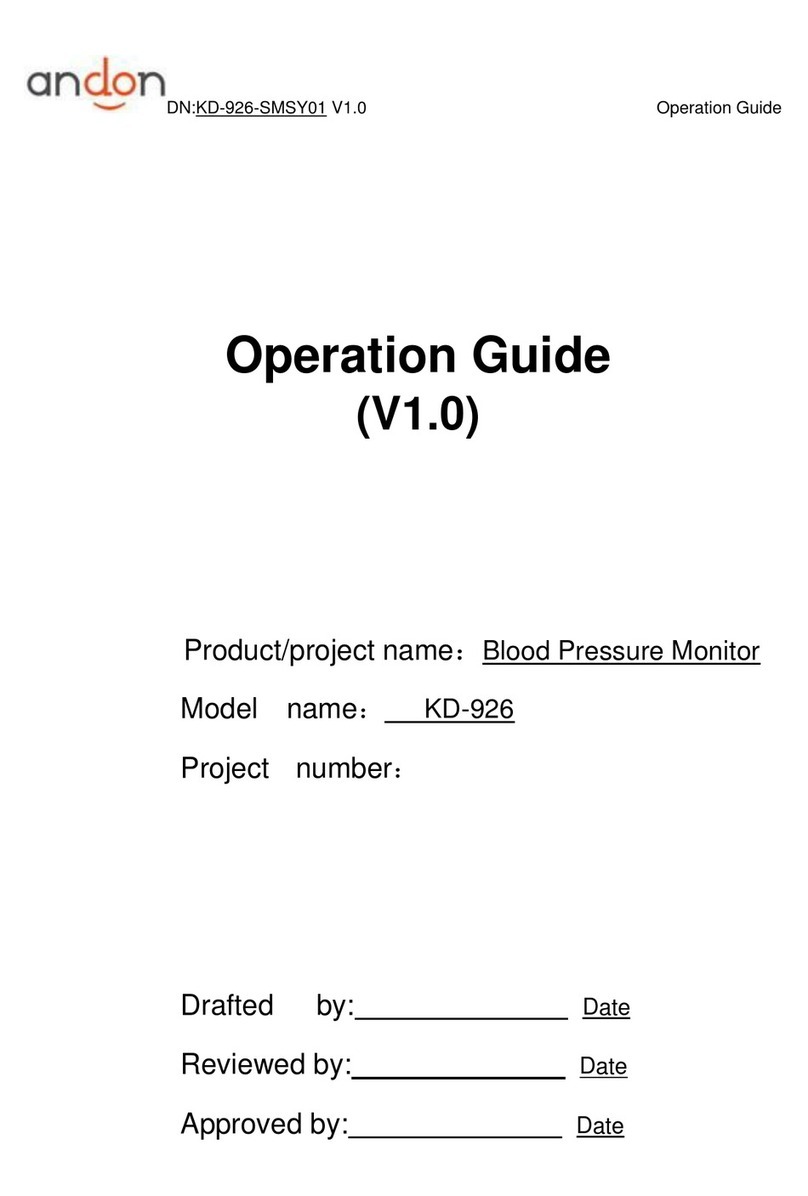AND UA-789XL User manual

Digital Blood Pressure Monitor
Model UA-789XL
Instruction Manual
Manuel d
’
instructions
Manual de Instrucciones
Manuale di Istruzioni
Bedienungsanleitung
使用手册
1WMPD4001765A


English 1
Contents
Dear Customers.................................................................... 2
Preliminary Remarks ............................................................. 2
Precautions........................................................................... 2
Parts Identification................................................................ 3
Symbols................................................................................ 4
Operation Mode.................................................................... 5
1. Normal Measurement With Storing Data ....................... 5
2. Recalling Data.............................................................. 5
3. Clearing Data............................................................... 5
4. Measurement With The Desired Systolic Pressure ......... 5
Using The Monitor ................................................................ 6
Installing / Changing The Batteries .................................. 6
Connecting The Air Hose ................................................. 6
Adjusting The Built-in Clock ............................................ 7
Setting Three Reminders.................................................. 7
Alarm ON/OFF Mark On The Display ................................ 8
Attaching The Arm Cuff ................................................... 8
How To Take Proper Measurements ................................. 8
Measurement................................................................... 8
After Measurement .......................................................... 8
Measurements ...................................................................... 9
Normal Measurement....................................................... 9
Measurement With The Desired Systolic Pressure ........... 10
Notes For Proper Measurement ...................................... 10
Recalling Memory Data ....................................................... 11
What Is An Irregular Heartbeat ............................................ 12
Pressure Bar Indicator ......................................................... 12
WHO Classification Indicator ............................................... 12
About Blood Pressure.......................................................... 13
What Is Blood Pressure? ................................................. 13
What Is Hypertension And How Is It Controlled? ............. 13
Why Measure Blood Pressure At Home? .......................... 13
WHO Blood Pressure Classification ................................. 13
Blood Pressure Variations............................................... 13
Troubleshooting ................................................................. 14
Maintenance ....................................................................... 15
Technical Data.................................................................... 15

English 2
Dear Customers
Congratulations on purchasing a state-of-the-art A&D blood pressure
monitor, one of the most advanced monitors available today. Designed
for ease of use and accuracy, this monitor will facilitate your daily blood
pressure regimen.
We recommend that you read through this manual carefully before
using the device for the first time.
Preliminary Remarks
This device conforms to the European Directive 93/42 EEC for Medical
Products. This is made evident by the mark of conformity.
(0366: The reference number to the involved notified body)
The device is designed for use on adults only, not newborns or infants.
Environment for use
The device is for use indoors.
Precautions
This device is designed for big arm. This device is not designed for using
the medium and small cuff. Only use Large cuff or Extra Large cuff.
Arm Size Recommended Cuff Size Order No.
32 cm to 45 cm Large cuff
UA-CUFDBKLA-EC
42 cm to 60 cm Extra Large
Precision components are used in the construction of this device.
Extremes in temperature, humidity, direct sunlight, shock or dust should
be avoided.
Clean the device with a soft, dry cloth. Never use thinner, alcohol,
benzine, or wet cloth.
Avoid tightly folding the cuff or storing the hose tightly twisted for long
periods, as such treatment may shorten the life of the components.
The device and cuff are not water resistant. Prevent rain, sweat and
water from soiling the device and cuff.
Measurements may be distorted if the device is used close to televisions,
microwave ovens, cellular telephones, X-ray or other devices with strong
electrical fields.
Used equipment, parts and batteries are not treated as ordinary
household waste, and must be disposed of according to the applicable
local regulations.

English 3
Parts Identification
Part of Display
Pressure Bar Indicator
and
WHO Classification Indicator
MEMORY Systolic Pressure
Diastolic Pressure
Pulse Rate
Battery Indicator
I.H.B. Indicator (Irregular heartbeat indicator)
Heart Mark
1.5v Batteries
(R6P,LR6 or AA)
Display
Air Connector Plug
START Button
(Blue illumination)
DC Jack
MEMORY Button
Battery Compartment
Battery Cover
CLOCK Button
Air Socket
Air Hose
Arm Cuff (Extra Large Cuff)

English 4
Symbols
Symbols Function / Meaning Recommended Action
Standby and Turn the device on.
Battery installation guide
Direct current
SN Serial number
Date of manufacture
Type BF: Device, cuff and tubing are
designed to provide special protection
against electrical shocks.
The indicator while measurement is in
progress. It blinks while detecting the
pulse.
Measurement is in
progress. Remain as still
as possible.
Irregular Heartbeat indicator. (I.H.B.)
The indicator that detects irregular
heartbeats or any excessive body
movement during the measurement.
Previous measurements stored in
MEMORY.
Full Battery
The battery power indicator during
measurement.
Low Battery
The battery is low when it blinks. Replace all batteries with
new ones, when the
indicator blinks.
Unstable blood pressure due to
movement during the measurement.
Try measurement again.
Remain very still during
the measurement.
The systolic and diastolic values are
within 10 mmHg of each other.
The pressure value did not increase
during inflation.
The cuff is not fastened correctly.
PUL. DISPLAY ERROR
The pulse is not detected correctly.
Fasten the cuff correctly,
and try the measurement
again.
SYS. Systolic blood pressure in mmHg
DIA. Diastolic blood pressure in mmHg
PUL./min. Pulse per minute
CLOCK button mark
Alarm ON/OFF mark of the reminder
If you want to stop the sound,
press the START button.
EC directive medical device label
WEEE label

English 5
Operation Mode
1. Normal Measurement With Storing Data (Refer to page 9)
Press the START button. Blood pressure is measured and data is stored
within the device. The device can store the last sixty sets of data in memory
automatically.
2. Recalling Data (Refer to page 11)
Press the MEMORY button to recall the data.
The date and the most recent data are
displayed.
The device can store the last sixty sets of
data in memory automatically.
3. Clearing Data (Refer to page 11)
Press and hold the MEMORY button until the “ ”
(memory) mark blinks to clear the stored data.
4. Measurement With The Desired Systolic Pressure
Refer to page 10 for the measurement with the desired systolic pressure.
Date
Data
Press the MEMORY button
Month
Day
Time

English 6
Using The Monitor
Installing / Changing The Batteries
1. Slide the battery cover up to open it.
2. Remove the used batteries and insert new
batteries into the battery compartment as
shown, taking care that the polarities (+)
and (-) are correct.
3. Slide the battery cover down to close it.
Use only R6P, LR6 or AA batteries.
CAUTION
Insert the batteries as shown in the battery compartment. If not, the device will
not work.
When
(LOW BATTERY mark)
blinks on the display, replace all batteries with
new ones. Do not mix old and new batteries. It may shorten the battery life, or
cause the device to malfunction.
(LOW BATTERY mark)
does not appear when the batteries are drained.
Battery life varies with the ambient temperature and may be shorter at low
temperatures.
Use the specified batteries only. The batteries provided with the device are for
testing monitor performance and may have a limited life.
Remove the batteries if the device is not to be used for a long time.
The batteries may leak and cause a malfunction.
Stored data are cleared when the batteries are removed.
Connecting The Air Hose
Insert the air connector plug into
the air socket firmly.
A
ir connector plug
Step 3
Step 1
Step 2
Air socket

English 7
Month / day
Hour / Minute
Clock
CLOCK button
CLOCK button
First
buzze
r
Third
buzze
r
MEMORY
button
Yea
r
Second
buzze
r
Using The Monitor
Adjusting The Built-in Clock
The device has a built-in clock. We recommend that you adjust the clock
prior to use.
1. Press and hold the CLOCK button until the digits start blinking.
2. Select the year using the START button.
Press the CLOCK button to set the current year
and move to month/day selection. The date can
be set anywhere between the years 2004 and
2053.
3. Select the month using the START button.
Press the CLOCK button to set the current month
and move to day selection.
4. Select the day using the START button.
Press the CLOCK button to set the current day
and move to hour/minute selection.
5. Select the hour using the START button.
Press the CLOCK button to set the current hour
and move to minute selection.
6. Select the minute using the START button.
Press the CLOCK button to set the current
minute and activate the clock.
Setting Three Reminders
This device has 3 reminder alarms. You can set 3
different reminder alarms within a 24-hour period.
1. Press and hold the CLOCK button until the digits
start blinking. Then press the MEMEORY button.
“P-1” is shown at the middle line of the display.
2. Select the hour using the START button and press the
CLOCK button to set the hour and move to minute
selection. Press the MEMEORY button to complete
the reminder setting after selecting the minute.
3. Then the display shows “P-2” for the second
reminder. Repeat the above process if you need a
second reminder.
4. A third reminder can be set as well.

English 8
Using The Monitor
Alarm ON/OFF Mark On The Display
When the alarm is on, a “p” appears on the LCD. To turn the alarm off, simply
press the CLOCK button once.
The alarm will sound for 1 minute. To stop the alarm sound, press the START
button once.
Attaching The Arm Cuff
1. Wrap the cuff around the upper arm, about
2-3 cm above the elbow, as shown. Place
the cuff directly against the skin, as clothing
may cause a faint pulse, and result in a
measurement error.
2. Constriction of the upper arm, caused by
rolling up a shirtsleeve, may prevent accurate
readings.
How To Take Proper Measurements
For the most accurate blood pressure measurement:
Sit comfortably at a table. Rest your arm on the table.
Relax before measurement.
Place the center of the cuff at the same height as your heart.
Remain still and keep quiet during measurement.
Do not measure right after physical exercise or a bath. Rest before taking
the measurement.
Try to measure your blood pressure at the same time every day.
Measurement
During measurement, it is normal for the cuff to feel very tight. (Do not be
alarmed).
After Measurement
After measurement, press the START button to turn off the power. Remove
the cuff and record your data.
Note: The device has an automatic power shut-off function, which turns the
power off automatically one minute after measurement.

English 9
Measurements
Model UA-789XL is designed to detect the pulse and to inflate the cuff to
a systolic pressure level automatically.
If your systolic pressure is expected to exceed 230 mmHg, read
"Measurement With The Desired Systolic Pressure" on the next page.
Normal Measurement
1. Place the cuff on the arm (preferably the left arm).
Sit quietly during measurement.
2. Press the START button.
The average blood pressures and last data
number are displayed briefly. Then the
display changes, as indicated in the figure
at the right, as the measurement begins.
The cuff starts to inflate. It is normal for the
cuff to feel very tight. A pressure bar
indicator is displayed, as in the figure at the
right, during inflation.
Note: If you wish to stop inflation at any time,
press the START button again.
3. When inflation is complete, deflation starts
automatically and (heart mark) blinks,
indicating that the measurement is in
progress. Once the pulse is detected, the
mark blinks with each pulse beat.
Note: If an appropriate pressure is not
obtained, the device starts to inflate
again automatically.
4. When the measurement is complete, the
systolic and diastolic pressure readings and
pulse rate are displayed. The cuff exhausts
the remaining air and deflates completely.
5. Press the START button again to turn off
the power.
Note: Model UA-789XL is provided with an automatic power shut-off
function.
At heart level
Starts inflation
Pressurizing
Measurement
in progress
Systolic pressure
Diastolic pressure
WHO classification
Pulse rate
Exhausts remaining
air automatically
START button
A
veraged data
Data number

English 10
Measurements
Measurement With The Desired Systolic Pressure
If your systolic pressure is expected to exceed 230 mmHg, use this
procedure.
1. Place the cuff on the arm (preferably the left arm).
2. Press and hold the START button until a
number about 30 to 40 mmHg higher
than your expected systolic pressure
appears.
3. Release the START button to start
measurement, when the desired number
is reached. Then continue to measure
your blood pressure as described on the
previous page.
Notes For Proper Measurement
Sit down in a comfortable position. Place the arm to be used for the
measurement on a table or other support so that the center of the cuff
will be at the same height as your heart.
Relax for about five or ten minutes before taking a measurement. If you
are excited or depressed by emotional stress, the measurement will
reflect this stress as a higher (or lower) than normal blood pressure
reading and the pulse reading will usually be faster than normal.
An individual's blood pressure varies constantly, depending on what you
are doing and what you have eaten. What you drink can have a very
strong and rapid effect on your blood pressure.
This device bases its measurements on the heartbeat. If you have a very
weak or irregular heartbeat, the device may have difficulty determining
your blood pressure.
Should the device detect a condition that is abnormal, it will stop the
measurement and display an error symbol. Refer to page 4 for the
description of symbols.
This device is intended for use by adults only. Consult with your
physician before using this device on a child. A child should not use this
device unattended.
Refer to the previous page
for measurement
Press and hold the button
At heart level
Release the button
at the desired
systolic pressure

English 11
Recalling Memory Data
Note: This device stores the last sixty measurements in memory
automatically. The data is retained as long as the batteries
are in the device. When you remove the batteries or the
batteries are drained, the data will be erased.
1. Press the MEMORY button.
2. The date and the most recent data are
displayed.
3. When the MEMORY button is pressed while
data is displayed, the previous data is
displayed.
4. After the last data is displayed, the display
goes blank.
5. Press and hold the MEMORY button until
the “ ” (memory) mark blinks to clear the
stored data.
Note: Pressing the START button while the memory data is displayed,
the device starts.
Date
Data
Press the MEMORY button

English 12
Example:
Moderate hypertension
Mild hypertension
High normal
What Is An Irregular Heartbeat
Model UA-789XL blood pressure monitor provides a blood pressure and
pulse rate measurement even when an irregular heartbeat occurs. An
irregular heartbeat is defined as a heartbeat that varies by 25% from the
average of all heartbeats during the blood pressure measurement. It is
important that you be relaxed, remain still and do not talk during
measurements.
Note: We recommend contacting your physician if you see this
indicator frequently.
Pressure Bar Indicator
The indicator monitors the progress of pressure during measurement.
WHO Classification Indicator
Each segment of the bar indicator corresponds
to the WHO blood pressure classification
described on the next page.
Inflation complete
Pressurizing
Inflation in progress Measurement in progress
Releasing air
WHO Classification Indicator
Severe hypertension
Moderate hypertension
Mild hypertension
High normal
Normal
Optimal
The indicator displays a segment, based
on the current data, corresponding to the
WHO classification.
:

English 13
About Blood Pressure
What Is Blood Pressure?
Blood pressure is the force exerted by blood against the walls of the arteries.
Systolic pressure occurs when the heart contracts. Diastolic pressure occurs
when the heart expands. Blood pressure is measured in millimeters of
mercury (mmHg). One's natural blood pressure is represented by the
fundamental pressure, which is measured first thing in the morning while one
is still at rest and before eating.
What Is Hypertension And How Is It Controlled?
Hypertension, an abnormally high arterial blood pressure, if left unattended,
can cause many health problems including stroke and heart attack.
Hypertension can be controlled by altering lifestyle, avoiding stress, and with
medication under a doctor’s supervision.
To prevent hypertension or keep it under control:
Do not smoke Exercise regularly
Reduce salt and fat intake Have regular physical checkups
Maintain proper weight
Why Measure Blood Pressure At Home?
Blood pressure measured at a clinic or doctor's office may cause
apprehension and can produce an elevated reading, 25 to 30 mmHg higher
than that measured at home. Home measurement reduces the effects of
outside influences on blood pressure readings, supplements the doctor's
readings and provides a more accurate, complete blood pressure history.
WHO Blood Pressure Classification
Standards to assess high
blood pressure, without
regard to age, have been
established by the World
Health Organization (WHO),
as shown in the chart.
Blood Pressure Variations
An individual’s blood pressure
varies greatly on a daily and
seasonal basis. It may vary by
30 to 50 mmHg due to various conditions during the day. In hypertensive
individuals, variations are even more pronounced. Normally, the blood
pressure rises while at work or play and falls to its lowest levels during sleep.
So, do not be overly concerned by the results of one measurement.
Take measurements at the same time every day using the procedure

English 14
described in this manual to get to know
your normal blood pressure. Regular
readings give a more comprehensive blood
pressure history. Be sure to note date and
time when recording your blood pressure.
Consult your doctor to interpret your blood
pressure data.
Troubleshooting
Problem Possible Reason Recommended Action
Batteries are drained. Replace all batteries with new
ones.
Nothing
appears on the
display, even
when the power
is turned on.
Battery terminals are not
in the correct position.
Reinstall the batteries with
negative and positive terminals
matching those indicated on the
battery compartment.
The cuff does
not inflate.
Battery voltage is too low.
(LOW BATTERY mark)
blinks. [ If the batteries are
drained completely, the
mark does not appear.]
Replace all batteries with new
ones.
The cuff is not fastened
properly. Fasten the cuff correctly.
You moved your arm or
body during the
measurement.
Make sure you remain very still
and quiet during the
measurement.
The cuff position is not
correct.
Sit comfortably and still.
Raise your hand so that the cuff
is at the same level as your heart.
The device does
not measure.
Readings are
too high or too
low.
If you have a very weak or
irregular heat beat, the device
may have difficulty in determining
your blood pressure.
The value is different
from that measured at a
clinic or doctor’s office.
Refer to “Why measure blood
pressure at home”.
Other
Remove the batteries. Place
them back properly and try the
measurement again.
Note: If the actions described above do not solve the problem, contact the
dealer. Do not attempt to open or repair this product, as any attempt to
do so will make your warranty invalid.

English 15
Maintenance
Do not open the device. It uses delicate electrical components and an
intricate air unit that could be damaged. If you cannot fix the problem
using the troubleshooting instructions, request service from your dealer
or from the A&D service group. The A&D service group will provide
technical information, spare parts and units to authorized dealers.
The device was designed and manufactured for a long service life.
However it is generally recommended to have the device inspected
every 2 years, to ensure proper functioning and accuracy. Please contact
either your authorized dealer or A&D for maintenance.
Technical Data
Type UA-789XL
Measurement method Oscillometric measurement
Measurement range Pressure: 20 - 280 mmHg
Pulse: 40 - 200 beats / minute
Measurement accuracy Pressure: ±3 mmHg or 2%, whichever is greater
Pulse: ±5%
Power supply 4 x 1.5V batteries (R6P, LR6 or AA) or
AC adapter (TB-242)
Classification Type BF
Clinical test According to ANSI / AAMI SP-10 1987
EMC IEC 60601-1-2: 2001
Memory Last 60 measurements
Operating condition +10°C to +40°C / 30%RH to 85 %RH
Storage condition -10°C to +60°C / 30%RH to 95 %RH
Dimensions Approx. 163 [W] x 62 [H] x 112 [D] mm
Weight Approx. 360 g, excluding the batteries
Accessory AC adapter The adapter is to connect the blood pressure
monitor to a power source.
TB-242 Please contact your local A&D dealer for
purchasing.
Note: Specifications are subject to change without prior notice.

English 16

Français 1
Sommaires
Chers clients......................................................................... 2
Remarques préliminaires ...................................................... 2
Précautions........................................................................... 2
Nomenclature ....................................................................... 3
Symboles.............................................................................. 4
Mode opératoire ................................................................... 5
1. Mesure normale avec les données conservées ............... 5
2. Rappel des données en mémorie ................................. 5
3. Effacement des données .............................................. 5
4. Mesure avec la pression systolique desirée................... 5
Utilisation de l’appareil ......................................................... 6
Mise en place / Remplacement des piles .......................... 6
Branchement du tuyau d’air ............................................. 6
Mise au point de la montre incorporée ............................. 7
Mettre en place les trois rappels d’alarme ........................ 7
Marque d’alarme MARCHE/ARRET sur l’affichage ............. 8
Mise en place du brassard................................................ 8
Comment faire des mesures correctes................................ 8
Pendant la mesure ........................................................... 8
Après la mesure............................................................... 8
Les mesures ......................................................................... 9
Mesure normale............................................................... 9
Mesure avec la pression systolique désirée .................... 10
Consignes et observations pour une mesure correcte..... 10
Rappel des données mémorisées ........................................ 11
Qu’est-ce qu’une frequence cardiaque irrégulière ? ............ 12
Indicateur du progrès de la pression................................... 12
Indicateur de la classification suivant l’OMS ........................ 12
Pression sanguine............................................................... 13
Qu'est-ce que la pression sanguine? .............................. 13
Qu'est-ce que l'hypertension et comment la contrôler? .. 13
Comment mesurer la pression sanguine chez soi?.......... 13
Classification de la pression sanguine suivant l'OMS ...... 13
Variations de la pression sanguine................................. 13
Recherche des pannes ........................................................ 14
Entretien............................................................................. 15
Fiche technique .................................................................. 15

Français 2
Chers clients
Félicitations pour l’achat de ce moniteur de la pression sanguine A&D
dernier cri, un des moniteurs les plus avancés disponibles aujourd’hui.
Etant étudié pour facilites d’utilisation et la précision, ce moniteur vous
aidera au quotidien dans la mesure de la pression sanguine.
Lisez ce manuel en entier soigneusement avant d’utiliser l’appareil
pour la première fois.
Remarques préliminaires
Cet appareil est conforme à la directive européenne 93/42 EEC des
appareils médicaux avec le marquage de conformité. (0366: Le
numéro de référence au corps notifié concerné)
Cet appareil est conçu pour tous excepté les nouveaux nés et les enfants.
Lieu d'utilisation
Cet appareil est destiné à une utilisation domestique.
Précautions
Cet appareil est conçu pour les bras forts. Il n’est pas conçu pour l’utilisation
des brassards moyen et petit. N’utilisez que le grand brassard ou le très
grand (XL) brassard.
Taille du bras Taille de brassard
conseillée N° de commande
32 cm à 45 cm Grand brassard
UA-CUFDBKLA-EC
42 cm à 60 cm Brassard extra Large
Cet appareil est équipé de pièces de précision. C'est pourquoi il faut
éviter de exposer à de fortes températures, une humidité extrême et au
soleil. De même il faut éviter les chocs et le proteger de la poussière.
Nettoyez cet appareil avec un chiffon doux et sec. N'utilisez jamais de
diluant, d'alcool, de benzène ou de chiffons mouillés.
Evitez de tordre le brassard ou de laisser le tuyau trop plié pendant de
longues périodes ce qui pourraient avoir une influence néfaste sur la
durée de vie des pièces.
L'appareil et le brassard ne sont pas imperméables. Evitez de les
mouiller avec de l'eau, de la transpiration ou la pluie.
Les mesures peuvent être faussées si l'appareil est utilisé près d'un poste
de télévision, un four à micro ondes, un téléphone cellulaire, des appareils
à rayon X ou tout autre appareil dégageant de forts champs électriques.
L'appareil usé, les pièces et les piles ne doivent pas être jetées comme
les déchets ménagers ordinaires, elles doivent être traitées
conformément à la législation en vigueur.
Table of contents
Languages:
Other AND Blood Pressure Monitor manuals


